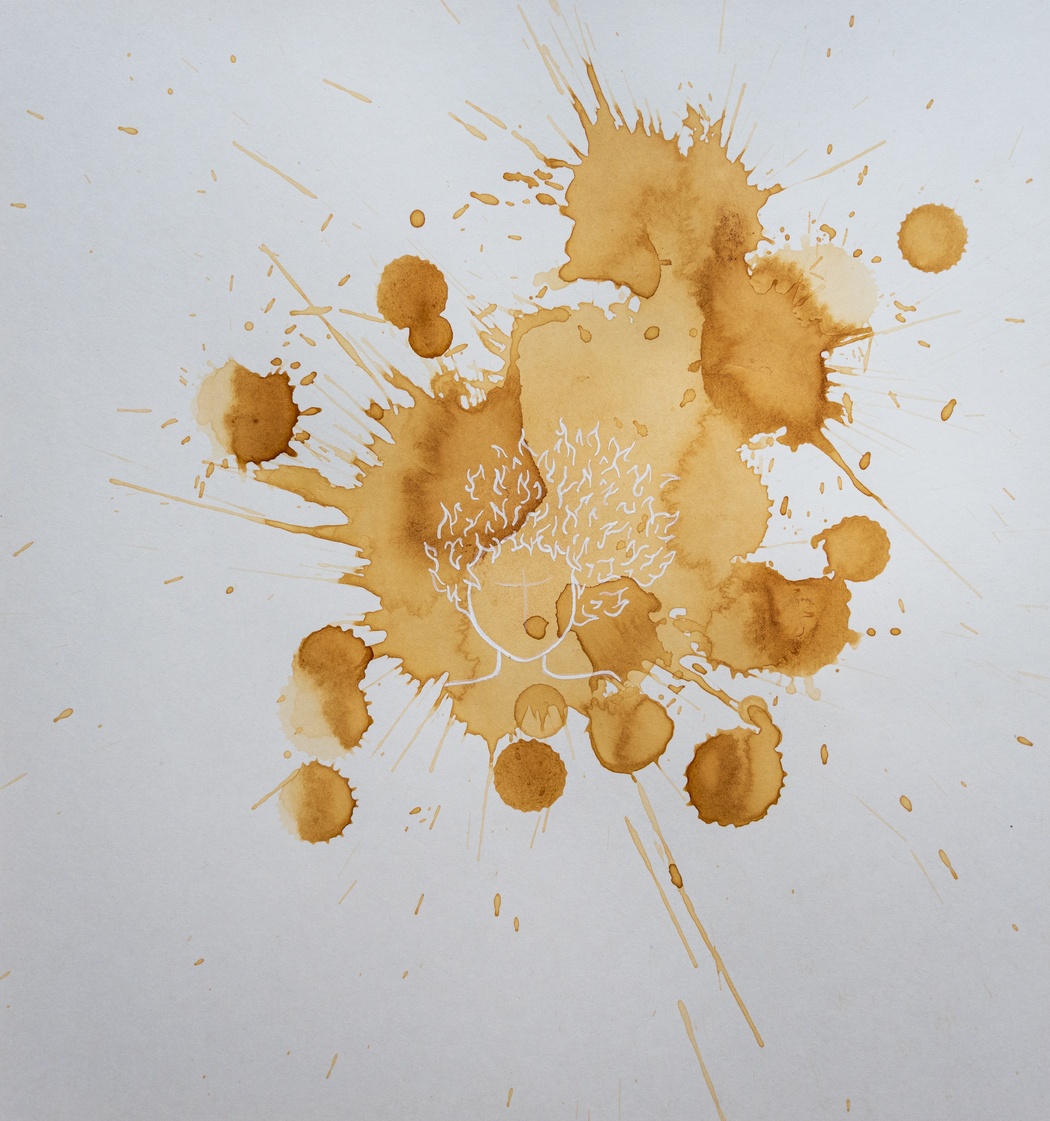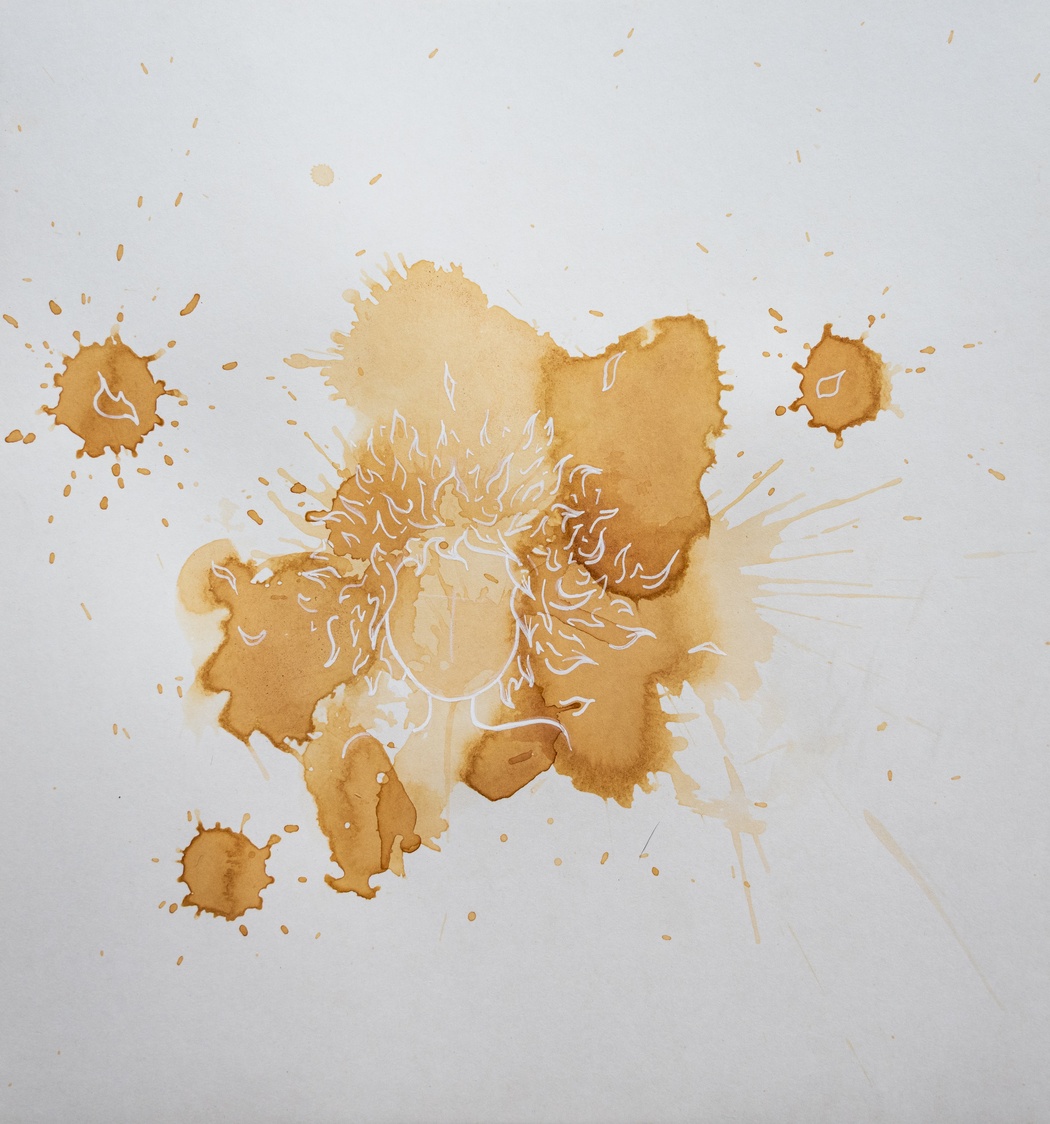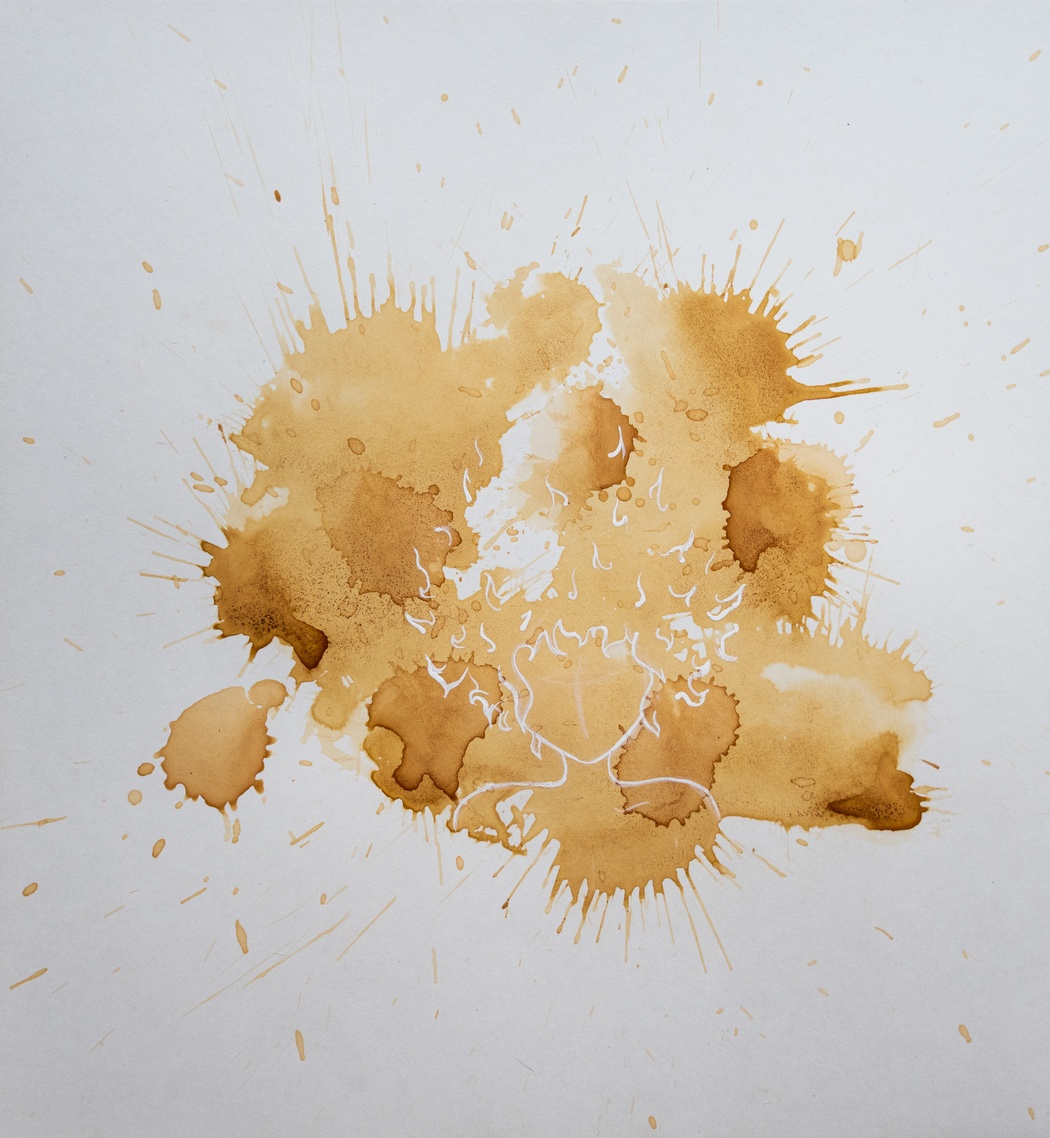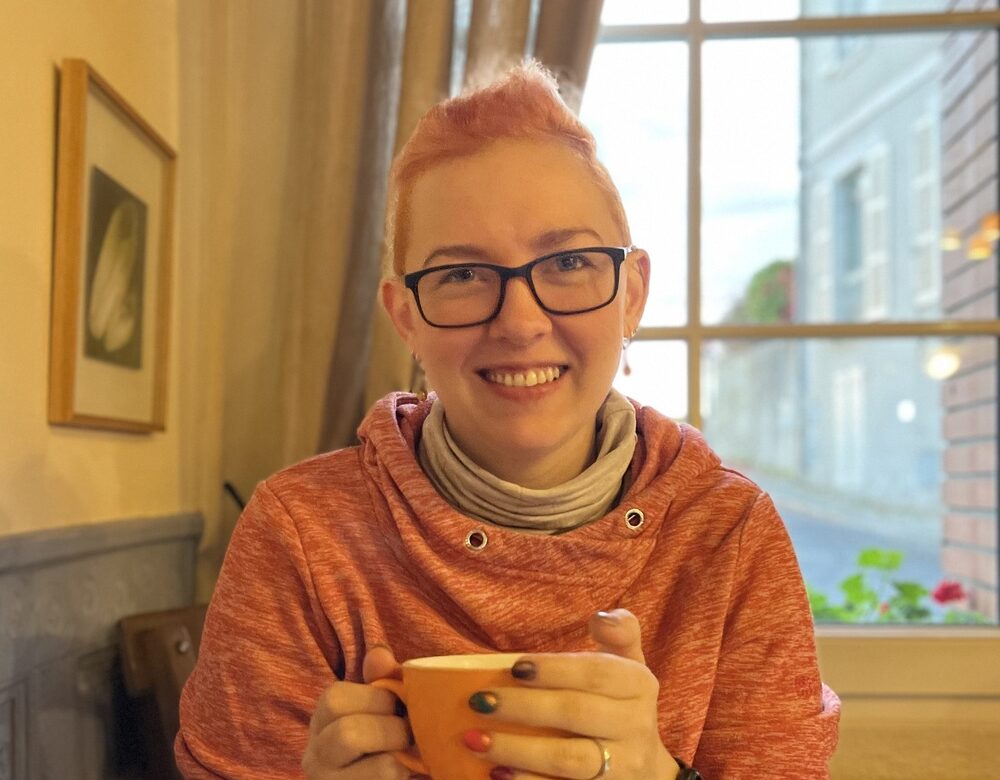Natasha Tresadern-Jones
Where do you live: Herefordshire.
Your education: First Class BA Hons Fine Art Combined Media, Swansea Metropolitan University.
Describe your art in three words: Intimate, Defiant, Ephemeral.
Your discipline: Tea-Led Mixed Media.
Tea as a medium is central to your work. What led you to choose tea as your artistic medium, and what does it represent for you personally?
I first began working with tea during my second year at university in Swansea, back in 2011. It started almost by accident. I was feeling a bit lost creatively, the practice I had been pursuing ran out of direction, and I found myself searching for something new. One day, while drinking tea (which I did constantly), a splash landed on some paper I had lying around. I doodled a rough compass map into it, and something just clicked. From that moment, it naturally evolved into a central medium for me. Over time, tea has come to hold deeper personal layers. I associate it with memories of specific mugs in different places, the comfort and sense of home that a cup of tea can offer. It became a symbol of familiarity in moments of uncertainty. In my third year, I also explored tea as a social ritual, contrasting traditional Chinese tea ceremonies with the casual British ‘cuppa’, and how tea can create a social interstice, a space outside the norm where people connect. I explored this concept in my dissertation. There’s also something powerful for me about the unpredictability of tea stains — even after working with them for so long, they still surprise me. I like that tea can leave ephemeral marks, stains that might be wiped away before they’re fully dry, like something unnoticed. It echoes both the emotional uncertainty I often feel and the quiet, often overlooked presence of my work within larger exhibitions. Tea’s unpredictability and fragility mirror my own approach to life and art: I rarely have a rigid plan, and instead, I follow where the process leads me.
Your work often explores emotional intensity and self-expression. How do you feel that tea as a medium captures these emotions, especially when paired with the fire-haired female figures?
With this most recent series, I’ve been moving through a period of intense transformation and transition, and meeting a lot of resistance along the way. There’s been this constant feeling of ‘the system won’t let you’ or ‘you can’t do that,’ and the emotional intensity behind these works really became an act of rebellion. The fire-haired women in my work represent the version of myself I know I can be: resilient, strong, and defiant. They’re like rising phoenixes, but even that image feels too polished; these women are raw, enduring forces who blaze their own trails. Sometimes they’re aspirational versions of myself, other times they’re reflections of women I admire, or they feel like a collective energy, a whole generation ready to rebel, to challenge the expectations placed on them. Tea stains as a medium capture all that intensity perfectly. Its unpredictability, the way it stains, bleeds, resists, mirrors the strong, volatile emotions that fueled this series: anger, resistance, defence, defiance. There’s a real tension between the delicate nature of tea and the tea ceremony, and the fierceness impacts that create the stains and the figures, and that friction, that push and pull, feels vital to the emotional impact of the work.
 Natasha Tresadern-Jones | Tenacitea | 2025
Natasha Tresadern-Jones | Tenacitea | 2025
In your statement, you mention the process of creating these pieces has been cathartic. Could you describe the emotional journey you experience while creating this series?
I create the works over two to three stages, often across a number of weeks. It begins with a very physical, emotional release: I set up several cups of boiling water with teabags and work into a small sketchbook. I focus on whatever emotions or challenges I’ve been facing, and then I physically collide the teabags with the pages. Depending on the heat of the tea, the teabags might be dropped, released, or even launched at the paper. It’s a quick, instinctive, sometimes chaotic process and it’s crucial to capturing the raw intensity of the feelings. Each teabag can only take a few impacts before it explodes, and while I try to avoid that (as it leaves overly dense marks), the unpredictability is part of the experience. After filling the sketchbook with these initial emotional impressions, I come back later to assess each piece, sometimes adding more layers where needed. The final stage is more careful and reflective: I draw in pen over the top, considering how they sit within the stained environment, how they can enhance or contrast the underlying emotions. The first stage is cathartic, energetic, and freeing — I try not to overthink — whereas the final stage demands more thought, precision, and respect for the marks already there. I don’t usually experience fear or resistance during the initial expressive stage; it’s very liberating. But when it comes to drawing the figure, there’s often a moment of hesitation or fear of making an irreversible mark. Once a piece is completed, though, there’s a real sense of pride. I’ve taken something born from struggle or negativity and transformed it into something resilient and alive. The only real ritual I follow during these stages is working alone, and if I’m building a cohesive series, I’ll stick to using the same type of tea throughout to maintain a consistent atmosphere.
You refer to tea stains as resembling ancient maps. Can you elaborate on how these stains connect to the concept of journeys to other times and places?
There are a few different layers to it for me. It goes back to one of my earliest tea stain experiments, the mark reminded me partly of a compass, and partly of an old, sepia-toned map. A literal map, hand-drawn with a certain flair, like something Tolkien might have created for Middle Earth — it’s a combination of imagination and grounded reality. At the same time, the stains also feel like emotional maps. They can read like a series of islands, spaces to be explored and understood. They’re records of emotional journeys, of time passing, of things lost to time. Sometimes they feel like a whisper of a moment, a fragment of a bigger conversation that was never heard, or something that needed saying but never found its voice. The tea is spilt, but there’s no clear evidence left behind. I don’t consciously think about the viewer when I’m making the work; in a way, it’s a very selfish process. These are my own explorations, my own feelings and emotions. I know they’ll inevitably be read and interpreted in different ways by others, but at their heart, the pieces are maps of my own internal adventures.
 Natasha Tresadern-Jones | Audacitea | 2025
Natasha Tresadern-Jones | Audacitea | 2025
The figures in your artwork embody strength and defiance. How do you view the role of women in your work, and what do these characters represent for you in today’s context?
There’s definitely one figure in this series that feels like a self-portrait, but overall, these women are also collective symbols of defiance. They represent the fight for equality, which is something we still haven’t fully achieved. Even today, there are still glass ceilings that haven’t been shattered, and I’m surrounded by strong women who continue to face challenges they shouldn’t have to. So there’s also a stubbornness, a fierce defiance in these women. They have a refusal to be diminished. These women are the fire that keeps you warm, the spark that lights the way. They’re the ones who burn down the forest so we can see what’s beyond, the beginning of a rebellion. They’re both strong and nurturing: unstoppable in pushing against the limits placed on them, but also the beacon of hope in a dark tunnel. The figures in my work are always unbound, uncontained, like the emotional force behind them. They do evolve, depending on the energy of the piece. This series has been quite fiery, but you can also see a softening happening, a fluidity emerging, though they remain raw and unfiltered.
How does your background in Fine Art and Photography influence your approach to this project? Do you incorporate any photographic techniques or concepts into your tea-based artworks?
I’ve always had a strong awareness of composition, and that directly influences how I approach the tea stains. When I’m working with the tea, I try to guide it within a certain frame, much like I would if I were composing a photograph. I think a lot about how the stains will look once they’ve dried, considering whether they lend themselves to the figure I want to draw or if something else will emerge organically within the marks. I pay close attention to the depth of the stains — during the second pass, I can feel when it doesn’t quite sit right or when the layering needs more attention. The key is in finding a balance. I’ve learned that trying to control the process too much leads to frustration, and often doesn’t give the desired outcome. It’s like working with light and shadow, there’s an element of intuition, letting things unfold naturally, but also knowing when to guide them. The tea, much like light, can be unpredictable and hard to pin down, and that tension is part of what makes the process so interesting.
 Natasha Tresadern-Jones | Defiantitea | 2025
Natasha Tresadern-Jones | Defiantitea | 2025
You have previously explored performance art. How do you feel the intimacy of working with tea in small-scale pieces compares to your larger performance pieces?
Tea has always been central to my performance art as well. The act of making tea itself became a kind of performance for me. Though the ritualistic nature of tea has faded from the traditional Chinese customs, there’s still something deeply intimate about it. Each cup made for a different person has its own nuances — the brand, milk, sugar, and the order in which it’s prepared, all tailored to individual preferences. I find comfort in that intimate nature, and that’s why I prefer to work in smaller-scale pieces, or rather, true-to-size pieces. The tea doesn’t scream to be noticed or overstated. It’s simply there, as it is. This current series feels more personal and inward compared to my previous performance pieces, though the themes and elements do repeat. For example, during my time in Swansea, I participated in a collective art piece called ‘Disruption,’ with various pop-up works across the city. My first disruption was quite oppositional. I set up a table with chairs on the street, offering tea to anyone who wanted it, with no expectations or strings attached. In a world obsessed with speed and convenience, it was a moment to pause, to converse or not, with no pressure. It’s rare now to find a place where you can enjoy a cup of tea without being asked to believe in something or buy something. In the second iteration, I took a more radical approach, setting up a performance in a post-apocalyptic world where trade had collapsed, and there was no tea. I prayed to the last tea plant, offering my body and empty mugs as tribute. But in the bleak world we’ve created, where we’ve failed to nurture the earth, the plant died. This piece took a darker turn, with shattered mugs and words raised in anger, illustrating the madness of a world without connection or conversation. In comparison, my current tea-based works are more inward and personal, focusing on the quiet intimacy of tea itself. The performance elements are still there, but they are more private now, allowing for a deeper personal connection to the material. I find myself letting the tea be what it is, without trying to force it into a performative framework, but the process still has echoes of that ritualistic, performative energy.


Leave a Reply